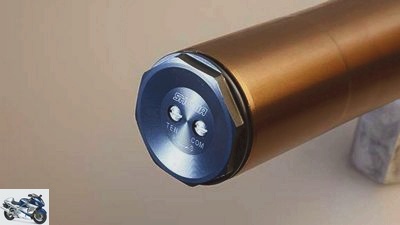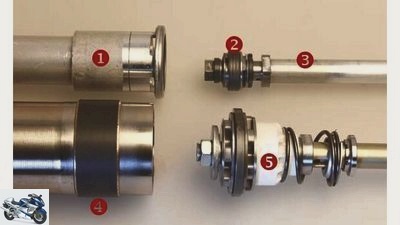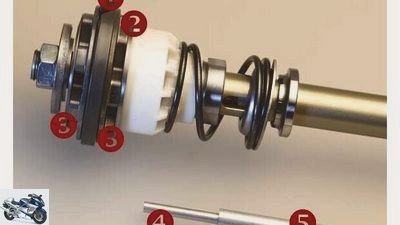Table of contents

fact
accesories
landing gear & Spring elements
Technology: suspension and chassis
Technology: suspension and chassis
New trend: Big Piston Fork
New trend in the supersport scene: the “Big Piston Fork”, an upside-down fork that makes the well-known damper insert superfluous. MOTORRAD shows what’s in the new Showa fork.
Werner Koch
07/05/2009
In order to build light and efficient motorcycles, there is no getting around multifunctional components. In modern engines, vibration-suppressing balance shafts drive oil or water pumps as a second task, and engine housings stiffen the frame assembly as a part-time job. The more functions are assigned to a component, the lighter, more efficient and more cost-effective the overall motorcycle package becomes. In this sense, the telescopic fork is a real masterpiece. It transmits the steering movements, serves as a wheel guide and takes over the suspension. A few clever Japanese minds now recognized the possibility of entrusting existing components with even more tasks with the current upside-down forks. The fork dip tube, which previously had to be used for wheel guidance and suspension, also serves as a cylinder for the hydraulic damping in the Big Piston Fork. “Stop”, call the technology freaks, “that’s old hat from the 60s and 70s.”

fact
Big Piston Fork, conventional cartridge system. 1: cartridge cylinder, 2: damper piston 20 millimeters in diameter, 3: damper rod, 4: immersion tube, 5: damper piston 39 millimeters in diameter.
In principle yes – but only in principle. The key difference: At that time, Japanese telescopic forks had a simple damper piston with differently sized holes in the standpipe that moved up and down. In fact, this system did something like controlled, but not adjustable, damping. And only then if viscous 30 fork oil had to press its way through the holes. With the current Big Piston Fork, a precisely machined damper piston with finely tuned valve plates controls the oil flow for each fork leg. So far, a damper system was used under the name of cartridge, which regulated the rebound and compression stage as a separate component in the fork. In order to accommodate this cartridge in the relatively small immersion tube diameters, delicate and small damper pistons and damper plates, the so-called shims, had to be used. Pistons around 20 millimeters in size and a small volume of oil in the cylinder make solid, controlled and smooth damping difficult, especially when the spring moves slightly.
Advantages and developments

fact
Damper system: 1: piston ring, 2: damper piston, 3: damper plates (rebound and compression stage), 4: rebound stage adjuster, 5: compression stage adjuster.
The new 39 millimeter damper piston with its shim packages mounted on both sides can control the oil flow much more precisely and can be fine-tuned. Another advantage of the Big Piston Fork: The piston works in both directions, so it controls the compression damping during compression and the rebound damping during rebound. Both attenuations are set at the top of the fork plug. In the conventional cartridge system, on the other hand, the piston moving in the cylinder only controls the rebound stage (rebound), while a second, firmly screwed damper piston on the cylinder base (base valve) takes over the compression damping (compression). This requires an adjustment mechanism at the top of the fork plug (rebound) and one at the bottom of the fork base (compression). “Aha”, says the critical observer, “here is now primarily saved.” In principle correct – but only in principle. If you disassemble the new Showa fork of the Suzuki GSX-R 1000 into its individual parts, there is no sign of massive cost savings. Countless small parts, such as the pretensioning mechanism of the spring, which works via a cone and now sits in the fork base, or the telescopic rods for the damper adjustment guided in the piston rod, demonstrate the technically complex design of the new system, which is around 300 grams lighter. But that doesn’t change the fact that there is still room for improvement with the Big Piston Fork. Chassis specialist Hubert Hofmann (www.hh-racetec.de) found around 30 percent more friction in test bench measurements than with the conventional cartridge system. Which is quite simply due to the piston rings being around twice as large.
But because the fine, sensitive response behavior of the telescopic fork is an important point on all types of motorcycles, there are some big question marks behind the Big Piston Fork. Also because the next logical development step in terms of suspension / damping, namely a closed, gas- or spring-pressure-assisted damper system, is already on its way. In MotoGP and in many commercially available series motocross machines, the gas pressure shock absorber for the telescopic fork will not be long in coming. The big advantages: absolutely constant damping in all temperature ranges, no foaming of the damper oil with the associated loss of damping force and even more setting and tuning options. “Uhh, more screws and bolts to adjust, who should look through it?” In principle correct, the objection – but only in principle. Because if you are looking forward to 180 hp, 300 km / h top speed and a lot of racing technology a hole in your stomach, you will also enjoy the low, high and mid-speed adjustment screws – even if you deliberately keep your hands off them.
Related articles
-
Suspension special: Part 3 – Strut damping
triumph accesories landing gear & Spring elements Suspension special: Part 3 – Strut damping Suspension special: shock absorber The right set-up for the…
-
Kawasaki 12th pictures Kawasaki 1/12 Current technical status: Kawasaki ZX 10R with 43 USD fork, Big Piston damping and relatively delicate triple trees….
-
Chassis special: Part 2 – fork damping
fact accesories landing gear & Spring elements Chassis special: Part 2 – fork damping Chassis special: fork damping Front wheel damping – the dream setup…
-
ZF equips Betamotor off-road bikes with chassis technology
beta accesories landing gear & Spring elements ZF equips Betamotor off-road bikes with chassis technology ZF equips off-road bikes Beta engine: perfectly…
-
Chassis special part 1: motorcycle suspension
fact accesories landing gear & Spring elements Chassis special part 1: motorcycle suspension Chassis special: suspension Everything about motorcycle…
-
Suspension guide – correctly adjusting the damping, part 2
Cook counselor workshop Adjusting suspension / damping correctly, part 2 Guide: correctly adjusting the suspension / damping, part 2 A mystery for many:…
-
fact counselor technology & future Workshop: chassis Workshop Chassis: adjust and improve correctly Content of “I can’t get the bucket around the bends…
-
BMW K model, new, for 2005: technology
MOTORCYCLE counselor technology & future BMW K model, new, for 2005: technology BMW K model, new, for 2005: technology The revealing Michael Pfeiffer…
-
The technology of the chassis and suspension
Bilski counselor technology & future The technology of the chassis and suspension Technology: rear wheel The technology of the chassis and suspension…
-
Safe on the move with semi-active chassis from ZF
BMW 7th pictures BMW 1/7 This is how potholes can disappear: The semi-active chassis system from ZF brings more calm to the motorcycle set-up, and thus…